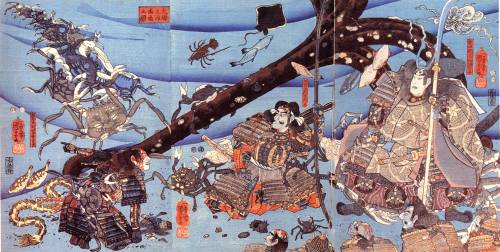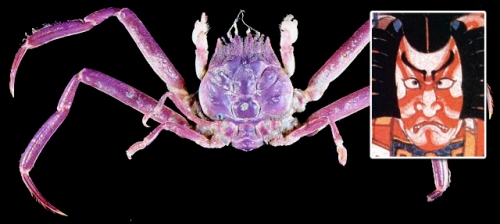I’m going to share with you two stories about the Samurai Crab, Heikea japonica; one is a ancient Japanese legend, and the other is a modern piece of scientific folklore. First, the historical background of the Japanese myth…
April of 1185 was the end of the line for the Heike Empire in Japan. Their rival clan, the Genji, swept across the southern Inland Sea of Japan and annihilated the final, desperate armada of the Heike at the battle of Dan-no-ura. The defeated Heike child-emperor and his samurai, refusing to surrender, committed suicide by throwing themselves from their boats to drown.
The battle of Dan-no-ura represented a massive cultural and political shift in Japanese history. It was the end of the imperial Age of Courtiers, and the beginning of the Feudal Era of Japan, lasting from 1185 to 1868. During this time, the majority of Japan was ruled by a powerful military dictator, the shogun, and his samurai warriors. Naturally, such geopolitical upheaval has strongly ingrained itself in the culture of Japan, and folklore stemming from the battle of Dan-no-ura survives today.
Popular legend alleges that, following the battle Dan-no-ura, the souls of drowning Heike samurai warriors were transformed into crabs. These crabs are distinguished by having the faces of the fallen samurai on their backs. To this day the Heike crabs roam the depths of the oceans around Japan, searching for the lost heirlooms of their empire.
 The ghost of the Heike general Taira no Tomomori (bottom left) at the bottom of the ocean with the anchor he used to drown himself following defeat at Dan-no-ura. He is joined by Heike crabs bearing the faces and souls of his comrades. By artist Utagawa Kuniyoshi, 17th century. Click to embiggen.
The ghost of the Heike general Taira no Tomomori (bottom left) at the bottom of the ocean with the anchor he used to drown himself following defeat at Dan-no-ura. He is joined by Heike crabs bearing the faces and souls of his comrades. By artist Utagawa Kuniyoshi, 17th century. Click to embiggen.
 Samurai crab, H. japonica and stylized Kabuki samurai face (inset). Click to embiggen.
Samurai crab, H. japonica and stylized Kabuki samurai face (inset). Click to embiggen.
Continue reading ‘Samurai Crabs: Transmogrified Japanese warriors, the product of artificial selection, or pareidolia?’
























